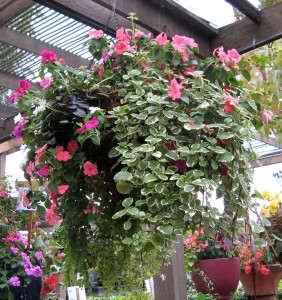
Living Bouquet Basket for shade
King’s has specialized in hanging baskets for many years. None are more fun to make or grow than the mixed baskets of flowers we call Living Bouquets. Planted and maintained correctly, they will give you an entire season of colorful blossoms. Making your own basket can be lots of fun, although quite a challenge for us to explain. The following is a guideline to get you started. If you have questions or need advice, drop by the Nursery; we’ll be happy to help.
What you will need:
A hanging basket, 12” in diameter or larger
A swivel hanger for the basket
Sphagum moss to line the basket
A bucket with water
Quality potting soil – we use MasterNursery “Professional Potting Soil”
Fertilizer – we use a combination of Master Start and Osmocote
A soil polymer such as SoilMoist (optional)
A selection of flowers, veggies, herbs, or greens
We need to grasp the concept that the moss is merely a liner around the basket used to hold in the soil. The moss is easy to work with when wet. That’s why we have the bucket. Submerge the moss in the bucket full of water. With the basket in front of you, take the moist pieces of moss out of the bucket. Smash the piece flat like a hamburger patty. Place the flattened moss in the bottom of the basket. Continue lining the bottom and sides of the basket, slightly overlapping flattened pieces of moss. Continue up the sides until you are about 1/3 of the way up. Remember the moss is merely a liner to hold the soil. There is no reason to completely fill the basket with moss. What you should now have resembles a bird’s nest in the bottom of the basket.
Into the nest, or depression, you want to pack in your potting soil/fertilizer mixture. Bringing it right up to the top of the moss. Your soil mix should consist of 1/3 cubic foot Potting Soil, 1/3 cup Osmocote, 2 Tbsp Master Start, and 1 to 2 Tbsp SoilMoist.
Now come the first of your plants. For a 12” basket, we only want to put 4 plants on the bottom layer. From the inside out – that means you are threading the foliage through the wire from the inside – place one plant at 12 o’clock, one plant at 3 o’clock, one plant and 6 o’clock, and one plant at 9 o’clock. Make sure the foliage extends outside the basket and the roots are inside, in good contact with the soil.
Smash down more moss and line the basket another 1/3 of the way up. Add more soil mixture to the top of the moss, packing down firmly, thus covering the roots of the plants already in the basket. On this layer put 6 plants, bracketing the 4 on the bottom row. When you have placed them to your satisfaction, continue lining the basket with moss all the way to the top, and slightly over the edge of the basket. Fill the basket to about 1” from the top with soil and pack down firmly. Plant 5 or more flowers in the top of the basket; 4 equaly spaced near the edges and one in the middle.
Carefully attach the wire hanger and water thoroughly but gently. You are now ready to hang the basket. Choose a location that is compatible with the plants you have chosen. As the basket matures, it will need more and more water. Daily during the summer is not too much. Water slowly and thoroughly. One gallon applied slowly is more efficient than three gallons squirted on. From time to time we feed with Maxsea, a superior liquid plant food.
When the season ends for your basket, you may salvage the basket, hanger, and some of the better moss. We always start over with new soil, fresh moss, and new plants. This produces a superior basket. That’s the entire procedure. Try not to skip any of the steps or materials as each is very important to the overall health and beauty od the basket. Remember, if you are confused, call or drop by the Nursery and ask for help. All of us at King’s have made many, many baskets and want yours to turn out great!
Finally, here are some guidelines for plant choices for your basket. Remember to put compatible plants together. All the plants in each basket should have similar requirements as to sun, water, etc.
Spring and Summer plants for the sun:
Lobelia
Petunia
Alyssum
Verbena
Marigold
Phlox
Zinnia
Golden Fleece
Bidens
Million Bells
Sanvitalia
Spring and Summer plants for the shade or part sun:
Impatiens
Lobelia
Schizanthus
Nemesia
Begonia
Mimulus
Bacopa
Fuchsia
Fall and Winter plants for sun:
Pansy
Viola
Winter Daisy
Dwarf Snapdragon
Toadflax
maybe Lobelia and Alyssum
Fall and Winter plants for shade and part sun:
English Primrose
Fairy Primrose
Cyclamen
Primula obconica
Ivy
maybe Lobelia, Nemesia, and Schizanthus
Let your imagination run wild. If you discover some new combinations that work for you, we’d love to hear about it…and see pictures!